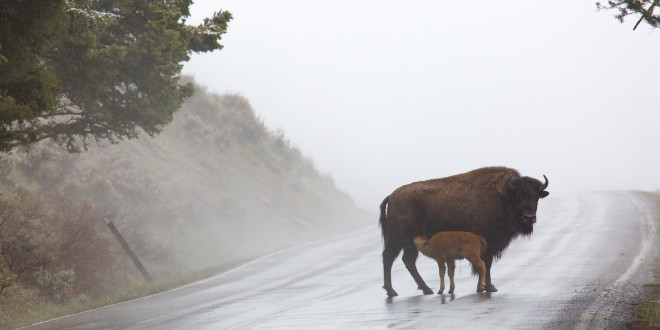A coalition of wildlife advocacy groups intends to sue the U.S. Fish and Wildlife Service and Department of the Interior over bison in Yellowstone.
Specifically, they intend to sue over bison should be considered a threatened or endangered species.
According to the Billings Gazette, earlier this week, Western Watersheds Project, Buffalo Field Campaign, and Friends of Animals filed a 60-day notice of intent, saying that the USFWS has not adequately considered the matter of placing bison on the Endangered Species List.
Further, earlier this year, the USFWS turned down two petitions seeking federal protections for the animal. One was originally submitted by Western Watersheds Project and the BFC; the other was filed by an unnamed individual.
All three groups argue that Yellowstone-area bison have been excluded from their historic range—and are threatened besides by hunting and slaughter. From the Gazette:
“Instead of allowing these bison to behave like bison and move with the seasons, government agencies are practicing indiscriminate killing that is destroying their genetic diversity,” said Michael Connor, the California director of Western Watersheds Project. “Protection under the Endangered Species Act is the only way to counter these government management inadequacies and other threats.”
Millions of bison once freely roamed throughout the Great Plains, but they were nearly driven to extinction in the 1800s through widespread hunting. The Yellowstone herd, roughly 4,900 animals, is the largest remaining wild population of bison that have not been bred with cattle.
Bison ranged over 7,700 square miles at their peak. Now their principal habitat is about 1,225 square miles within Yellowstone, from which they migrate in winter in search of food, according to the Fish and Wildlife Service. Outside of the park, bison face hostility from ranchers and landowners concerned with the spread of disease and the destruction of property.
Some bison caught outside the park are slaughtered as a population-control measure by the Interagency Bison Management Plan, which was created by a group of federal, state and tribal officials. More than 8,000 Yellowstone bison have been killed since the 1980s, most by slaughter.
Hunters outside the park boundaries kill hundreds more each year.
This is not the first legal challenge issued this year over Yellowstone bison. In January, a pair of advocates (journalist Christopher Ketcham and BFC member Stephany Seay) filed a lawsuit against the Park over media access to the Stephens Creek Bison Capture Facility, where bison are corralled and tested annually.
On the whole, the USFWS and Yellowstone officials have argued that the Park’s bison population is thriving, hunting and culling aside. In evaluating the original petitions, the USFWS said they “do not present substantial scientific or commercial information indicating the petitioned action may be warranted for Yellowstone bison.”
The possible plaintiffs in this lawsuit have said the USFWS, in denying consideration for ESA designation, has not heeded “the best scientific information” available, adding that hunting and slaughter negatively impacts the population’s genetic diversity.
The past year has seen several developments in the bison debate. Late last year, Montana Governor Steve Bullock signaled approval to permit bison to roam year-round in parts of southern and southwestern Montana. Bullock’s measure was later approved by the IBMP’s partner agencies and tribes. And Park officials, such as Superintendent Dan Wenk, have said changes in bison management are likely forthcoming—although adding that operations at the Stephens Creek are expected to continue for the near future. Just a few months ago, the bison was named America’s national mammal.
All three groups have said they will sue unless the USFWS reconsiders the petitions. If accepted, the USFWS would undertake a 12-month review of Yellowstone’s bison population to evaluate whether they qualify for ESA protections.
 Yellowstone Insider Your Complete Guide to America's First National Park
Yellowstone Insider Your Complete Guide to America's First National Park





